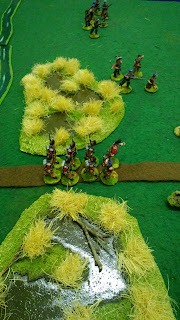Late 1943 and 94th (Saxon) Infantry Division are dug in expecting an onslaught. Through the snow, diesel engines are rumbling and tank tracks start to clank. A Soviet Tank Corps is on the move!
 |
| 94th Infantry (L-R, Fran, Me) |
The scenario pitted a significantly understrength German Infantry Division (Myself and Fran) against a nearly full strength Soviet Tank Corps (Alex, Ian and Jon) in late 1943. Snow was on the ground, the rivers were frozen so that all units could cross anyway barring Heavy Armour (e.g KV-1s). We used the Spearkrieg amalgamation rules (because they work) and the scenario (and bulk of the figures) was provided by Alex (and Pendraken).
94th Division was deployed with 2 Regiments up, 1 in reserve. (See Stalingrad TOE). The only hidden deployment was the hidden location of our limited anti-tank guns as well as the garrison strengths of the front line villages. We were promised that a Panzer Division would be sent to assist.
 |
| Soviet Initial Deployment (L-R, Ian, Jon, Alex) |
The Soviets initially deployed 3 Tank Brigades, no subtlety involved, just try and overpower the German defenders.
 |
| Massed Soviet Armour |
I'd like to say that my viewpoint was very focussed on the German right so I'm going to concentrate on the actions there - hopefully Ian, Jon or Fran can describe what happened on the left.
 |
| Initial Soviet Left Flank Assault Force |
The surprisingly high Soviet Command Values led to rapid advances and early pressure appeared to be applied along the line. But in some ways the lack of Anti-Tank Guns an vehicles meant that actually the Soviets couldn't actually see there opponents whilst the German could call in Artillery, Mortars and Anti Infantry Guns with surprisingly good effects.
 |
| German 15.0cm Infantry Gun - Game Changer! |
Around Turn 4 the line was still holding (still no Panzers) when a message was sent to Divisional HQ from OKW, Advance! (This is based on a Spearhead scenario and a historical event). At this point I remember Fran "bravely" ordering his Engineers to leave their trenches and flme the tanks in front of them - taking out a couple of platoons (but leaving themselves horrendously exposed).
 |
| A breach. |
Finally the ongoing tank fire was to much for my 1st battalion and they retreated - abandoning their positions and leaving a hole in the lines - it would have been interesting if we'd have had a couple more turns to see if the Soviets could have exploited this. Instead the towns were assaulted again and again, and again and again and eventually despite throwing back multiple assaults, the engineers fell and Jons infantry was able ot seize the village.
 |
| The Village Falls. |
All in all a great game and an interesting scenario, it just goers to show that combined arms works and if you fire enough of it, even tanks are susceptible. Thanks Alex.
 |
| Vietnamese Village |
Other games included Bloodbowl, a Crusaders game (sorry don't know ruleset) and a Vietnam Force on Force Game.
Cheers JR















































